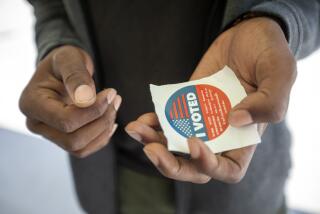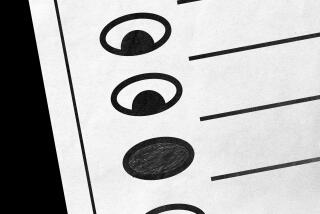Recall Vote Underscores Weight of Absentee Ballot
- Share via
Election Night in San Gabriel last month was like a tense, slow-motion basketball game, with the lead seesawing back and forth late into the evening. Partisans in the hotly contested recall campaign huddled at City Hall in worried little groups or paced the aisles in the City Council chambers, groaning or cheering with the announcement of each new batch of results.
First the pro-recall forces, who wanted to have Vice Mayor Frank Blaszcak thrown out of office, took a slender lead in the ongoing tally posted above the vote-counters. Applause from the north side of the room. Then Blaszcak surged in front by a commanding 99-vote margin with more than half of the votes counted. Cheers from the south side.
But Blaszcak and his supporters hadn’t figured on the absentee vote. The “yes” votes (for recall) carried the absentees by a whopping 160-vote margin out of 550 cast. It was, the anti-recall forces conceded, the crusher. The final result, announced the next day: Blaszcak won the precinct-by-precinct vote handily but lost the election by nine votes.
The absentee ballot gambit, with campaign organizations encouraging sympathetic target groups to vote by mail, is becoming a part of the strategy in elections all over California. The technique has been especially effective in initiative, referendum and recall elections, where even small blocs of voters can have a commanding influence.
Once a mere convenience for voters who might have difficulties getting to the polls, the absentee ballot has become an effective tool in skewing the results, researchers say. So successful have some political consultants been in its use that the absentee ballot is beginning to raise some questions about, as one analyst put it, “the potential for abuse.”
“There are greater possibilities for voter fraud, as people rely more on a mail-in ballot as opposed to an actual person showing up at the precinct polling place,” said Mark DiCamillo, managing director of the San Francisco-based Field Institute, which produces the California poll.
With a large segment of the electorate voting outside of the polls, sometimes as much as four weeks before Election Day, the mail-in ballot has, at the least, produced fundamental changes in the voting process in this state, DiCamillo said.
California has the most liberal absentee ballot law in the country, said William Kimberling, deputy director of the Federal Election Commission Clearing House of Washington. Until 11 years ago, a voter had to have a valid reason--such as being ill, disabled or out of town on Election Day--to qualify to vote absentee. But the so-called Lehman Bill, named for its sponsor, Democratic Assemblyman Richard H. Lehman of Fresno (now a U.S. congressman), eliminated all the restrictions. After the bill passed in 1978, anyone who qualified to vote also qualified to use the absentee ballot.
Other states including Washington, Oregon and Texas have since passed similar laws, but none is as loose as California’s, Kimberling said.
“It’s the double whammy that makes it so remarkable,” Kimberling said. “Not only have all the barriers been dropped, but the state facilitates the process” by mailing sample ballots, each including an application for an absentee ballot, to all registered voters.
And campaign organizations have gotten in on the process, printing their own applications for absentee ballots and circulating them among supporters.
“The combination makes absentee voting in California by far the easiest of all the states,” said Kimberling.
The result has been some dramatic increases in the numbers of absentee voters. The California Opinion Index has tracked the state’s absentees in presidential elections, from 1960, when the mail-in vote was 3.9%, to 1988, when it was 14.1%--one out of every seven voters using absentee ballots.
“It’s now a big chunk of the vote,” says DiCamillo. “On Election Day now, you have to be aware that the precinct vote is only a portion of the vote.”
That first became apparent in the 1982 gubernatorial election, DiCamillo said, when Los Angeles Mayor Tom Bradley held a slim lead until the absentee votes came in. George Deukmejian carried the absentees by better than 2 to 1 and eked out a victory.
DiCamillo’s organization has drawn a profile of the absentee voter, based on its own survey and on television network exit polls after the last presidential election. The absentee voter is more likely to be “older, male, more conservative in politics generally,” said the opinion index. The absentee voter also “favored the GOP candidates for President and the U.S. Senate to a greater degree than did precinct voters.”
Campaign Technique
Tweaking the electorate with absentee ballots “has become a pretty generalized campaign technique in the past four or five years,” says consultant Lynn Wessel, who ran Azusa real estate investor Johnny E. Johnson’s unsuccessful 1987 campaign to have the Azusa Green Country Club turned into homes, apartments and light industry.
The strategy usually goes like this, local campaign managers and consultants explain:
First, identify a target group sympathetic to your cause. Depending on the issue, such groups, associated with particular neighborhoods or points of view, can be separated from the rest of the electorate like a wedge in a pie, says Wessel. For example, in South Pasadena two weeks ago, supporters of a parcel tax for education concentrated on the parents of schoolchildren, where a survey had indicated that support for the measure exceeded 80%.
Finding your support group and developing a list of its members is what Wessel calls “fine-tuning” a campaign.
Then use your list, not just to get out the vote, but also to send out “vote-by-mail” appeals and absentee ballot applications. “It’s a way of offsetting low voter turnout in special elections,” said Wessel. “You reach out to as many people as possible and give them the opportunity to vote absentee.”
The result can be an inordinately heavy “turnout” from a particular bloc of voters, many of whom support your cause but aren’t motivated enough to go to the polls on election day.
Just as elsewhere in the state, campaign managers in the San Gabriel Valley are catching on. Absentee ballots have been important, occasionally decisive, in races such as these:
The South Pasadena parcel tax election June 6. Supporters of the measure printed absentee ballot applications and targeted about 2,400 parents. But strong support from the parents, said campaign spokesmen, couldn’t outweigh apparently deep-seated resistance from elderly voters, about 27% of the city’s population and an even larger segment of the city’s 13,412 voters. The measure, which required a two-thirds vote, fell short by more than four percentage points. But it was the pro-tax group’s lack of success with voters other than parents who cast absentees ballots that lost the election.
The war of the Pasadena “growth management” initiatives March 7. Strategists for Pasadena Residents in Defense of our Environment (PRIDE) had been compiling its list of supporters for two years, pitting its initiative against a more limited one, drafted by the city government. Although the absentees were not crucial, said PRIDE co-chairman Michael Salazar, their strong support for PRIDE, significantly higher than among precinct voters, added to the PRIDE initiative’s commanding mandate.
The Azusa Greens initiative election, Oct. 6, 1987. Again, the absentees did not decide the election. But it was a central part of the strategy of those opposing the plan to develop Azusa’s golf course, the city’s only significant greenbelt. “Because of voter apathy, it’s harder to get people out,” said Howard Kennedy, the opposition group’s chief strategist. “You use absentee ballots to get them to vote on an issue that’s emotional for them, but not emotional enough to get them to drive to a polling spot.” Absentees opposed development by almost 2 to 1, while the overall vote was against the principal initiative by 54%.
In the San Gabriel election last month, Blaszcak was supported by Citizens for Responsible Development, a slow-growth group that had dominated the city’s politics for two years.
Group Printed Applications
Depending on who is telling the story, the pro-recall forces either compiled a list of potential supporters from contacts made through door-to-door campaigning or they employed copies of the recall petitions against Blaszcak, signed by more than 3,200 voters. In any event, the group printed 3,000 of its own applications for absentee ballots and distributed them to everybody on the list.
“You use anything you can,” said Councilman Sabino Cici, a Blaszcak rival and one of the strategists in the winning campaign. “It used to be that you ran on your own merits. You knocked on doors by yourself and ran your own campaign. It’s different now.” For that election, Cici said, pro-recall forces “went to families, friends, anybody. The idea was: If you take a ballot to him, he’ll vote.”
“In future elections, we’ll do the same thing,” vowed Gary Meredith, a key Blaszcak strategist in the faction-divided city. “We’ll have to go full press.”
Defenders of the widespread use of the absentee ballot say that it extends the “window of voting” from 13 hours on Election Day to a three- or four-week period, giving voters more of a chance to ponder complicated ballot initiatives. It also avoids voter drop-off because of bad weather.
But Meredith and others say the heavy use of absentee ballots raises the specter of “house-to-house electioneering.”
“Something you can’t do at the polls, you can do at somebody’s house,” said Meredith, a marketing and advertising consultant who has been involved in San Gabriel politics for two years. “You can target a home, give the voters applications for absentee ballots, then talk to them again (when they’re filling out their ballots). It’s all done in the privacy of the home. It’s electioneering and campaigning, but nobody sees it.”
Objection to Early Voting
He also objected to early voting by many absentees, who could have received and submitted their ballots as much as four weeks before the election. “They’re missing most of the campaign,” Meredith said.
Curtis Gans, director of the Committee for the Study of the American Electorate, a Washington nonpartisan research group, and a frequent critic of voting practices, said the issue warrants further study.
The California approach is increasingly appealing to other states, which are suffering from decreasing voter turnout, he said.
But the California law appears to invite misuse, he said. “It’s ease versus integrity, access versus narrow manipulation,” he said. “I’m not entirely comfortable with the degree of liberality that California has. But I don’t want to pass judgment at this point. I want to study it.”
More to Read
Sign up for Essential California
The most important California stories and recommendations in your inbox every morning.
You may occasionally receive promotional content from the Los Angeles Times.










